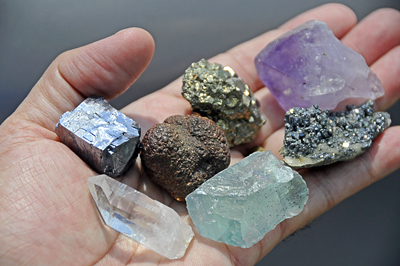
With nearly 3000 different known minerals, you might think that identifying mineral specimens would be difficult. Actually, it is usually fairly easy. Many of those 3000 minerals are very rare, only found in very limited areas. If you can learn to identify twenty or thirty of the most common minerals, you will be able to identify most of the specimens that you are likely to find.
Before you can identify minerals, you need some minerals to identify. Luckily, there are many places to get mineral specimens.
You should also download the Mineral Identification Chart and print a copy. We will be using this chart to learn the ID tests, and to identify unknown specimens.
Things to keep in mind as you perform these tests:
- Keep safety in mind. Use work gloves and eye protection when breaking specimens. Some minerals, especially those which a conchoidal fracture can be VERY sharp when broken.
- Don't perform damaging tests (hardness, cleavage, fracture, streak) on valuable or prized specimens. Always collect some average specimens of each mineral for testing.
- As you are learning the tests, start by testing specimens that have already been identified. It is easier to recognize luster, cleavage, fracture, etc. if you know what the result should be. Once you get a feel for the properties, then you can try identifying some unknown specimens.
- If your specimen has been weathered or tumbled in a stream, test a freshly broken surface if possible. Think how much rust changes the appearance of a piece of iron. A fresh surface lets you see the actual color and luster. It will also help you get a more accurate result for hardness.
- The Mineral Identification Chart shows some very common minerals, but there are nearly 3,000 known minerals. If you collect many minerals, you will probably find specimens that are not on this chart. If you find a mineral that does not fit any of those in the chart, try a more detailed source. My favorite mineral reference is Simon & Schuster's Guide to Rocks & Minerals
.
- Look carefully at your specimen before testing. It is common to have several different minerals on one specimen. Be sure that you use the same part of the specimen for every test.
